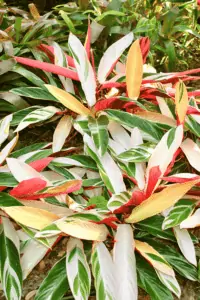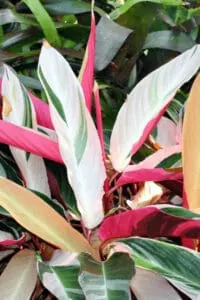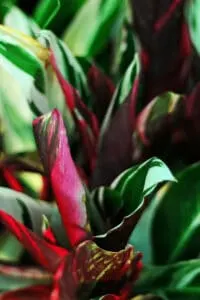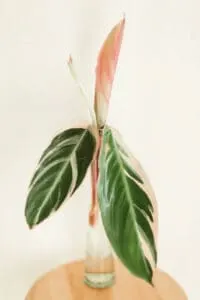The Stromanthe sanguinea goes more commonly by the name Stromanthe Triostar or simply Triostar or Tricolor according to the University of Florida.
The University of Wisconsin-Madisons states that it is a tropical perennial from the maranta and prayer plant family (Marantaceae) family and is native to parts of the Brazilian jungles and rainforest.
Its striking leaves are what draw plant lovers in.
With vibrant mixes of cream, pink and pale green on the top of its leaves and maroon to deep pink mixes underneath.
Unfortunately, this plant is not one for beginner gardeners.
Stromanthe sanguinea is considered quite difficult to keep thriving and thus is better suited to more experienced indoor gardeners.
This is due to their rather specific care needs and specifications. If not given their way it is not uncommon for this plant to ‘throw a tantrum’!
Table of Contents
Stromanthe sanguinea Care
Stromanthe sanguinea need bright, indirect sunlight. Their soil must be moist but light and well-draining. The temperature is between 65℉ and 80℉ (18.3℃ and 27℃). Humidity is important. Provide high humidity of 50% and more. Fertilize every 2-3 weeks using a balanced fertilizer in the growing season.

Stromanthe Sanguinea Care
Stromanthe sanguinea Care Guide
Soil
Stromanthe sanguinea requires light, well-draining soil that still retains some moisture. A perlite-based potting soil mix is ideal. Soil pH levels are not of extreme importance, however, levels between 6.0 and 8.0 are best.
The Stromanthe Triostar should be planted in a light soil type. It needs a soil that holds moisture but still drains freely. Ideally, a potting soil that is peat-based should be used. An equal part mix of perlite and potting mix will also do the trick.
This plant is not too concerned when it comes to soil pH. However, keeping a soil pH between 6.0 and 8.0 is recommended.

Stromanthe Sanguinea needs well-draining soil that retains moisture
Light
Stromanthe sanguinea plants are prone to sunburn. Keep them out of direct sunlight. Ideal exposure is moderate to bright, indirect sunlight. The more indirect light it receives, the better its variegation will show. A spot by an east or north-facing window is best. Turn the plant once a week for even growth.
Stromanthe sanguinea’s crave bright but indirect sunlight.
Medium levels of indirect sunlight are suitable, but the brighter the indirect light they receive, the better they will grow.
A Stromanthe Triostar plant that is getting a maximum amount of indirect sunlight will grow leaves with much more variegation.
Even though more variegated foliage can be seen by plants growing in brighter locations, exposure to direct sunlight should be avoided.
Exposure to direct sunlight can result in your plant becoming sunburnt.
Placing your Stromanthe sanguinea by a window that is either north-facing or east-facing would be ideal.
For best growth results, you should turn your Stromanthe Triostar once per week. This plant’s leaves grow towards its light source. So, turning it every few days will ensure even growth throughout the plant.
Watering
Stromanthe sanguinea enjoy moist but not waterlogged soil. Check the soil moisture before watering it. When the top inch of soil has dried, it is time to water your plant. Water it deeply and thoroughly and then allows excess water to drain. Empty the drainage tray so the plant is not left to sit in water.
Stromanthe Triostar’s like their soil to be kept just barely moist.
They do not like to be left to dry out completely. Once the top inch of their soil is dry to touch, it is time for some more water.
The best method to use when watering your Stromanthe sanguinea is the deep watering method.
Pour water at the base of your plant until it begins to flow out the pot’s drainage hole.
Allow some time for the excess water to drain from the pot and into the catchment tray.
Remember to empty the tray once this is done as this plant does not like to stand in water.
Nor does it take it kindly to have waterlogged soil.
In the winter months, reduce watering frequency.
Monitor your plant’s soil moisture carefully so as not to overwater it. Too much water will result in root rot.
Temperature and Humidity
Stromanthe sanguinea should be kept in temperatures between 65℉ and 80℉ (18.3℃ and 27℃). They can tolerate temperatures down to 40℉ (4.4℃) but keeping them in this environment is not recommended.
Stromanthe sanguinea likes to be kept in high humidity levels above 50%. Very dry conditions should be avoided.
Stromanthe Triostars are considered cold-hardy plants.
They are capable of surviving temperatures as low as 40℉ (4.4℃). However, as they are tropical plants, they much prefer to be kept in average to warmer temperatures.
Specifically, temperatures between 65℉ and 80℉ (18.3℃ and 27℃).
Along with warmer temperatures, the Stromanthe Triostar is a lover of humidity.
Humidity levels of 50% and more are favorable. The higher the humidity, the better your plant’s foliage will look.
Keeping this plant in a humid environment will aid in keeping its soil moisture levels comfortable.
Ideally, you should mist your Stromanthe Triostar every day to keep the humidity level around it at a desirable level.
Or, if possible, keep it in a spot that has a higher humidity such as in the kitchen or the bathroom.
The other option is to make use of a pebble tray for your plant.
This is as simple as placing a few pebbles in a tray of water and placing your Stromanthe sanguinea on top of the pebbles.
Avoid keeping this plant in very dry environments.
Being exposed to these undesirable environmental conditions will result in the plant turning brown.
Its leaves will also likely become crispy. Areas with air conditioning, dry heat, or drafts should also be avoided.

Stromanthe Sanguinea prefers high humidity above 50%
Fertilizer
Apply a balanced, liquid fertilizer once every two to three weeks during the spring to summer months. Be sure to dilute the fertilizer to only half strength before application. Do not fertilize your Stromanthe Triostar during the winter season as it may result in root burn.
The Stromanthe Triostar experiences its growing season from spring through summer.
This is the best time to feed your plant as it will actively use the fertilizer you provide.
You should ideally fertilize your Stromanthe sanguinea once every two to three weeks.
Using a balanced, liquid fertilizer diluted to half the recommended strength.
During the colder months of winter, this plant goes into a period of dormancy.
Do not fertilize your Stromanthe Triostar during this time.
Doing so will likely result in the fertilizer burning your plant’s roots.
This is because the plant is not actively growing at this time and cannot make use of the fertilizer.
Growth
This is a slow-growing plant and is unlikely to flower. Its colorful foliage makes up for that with its span of up to 2 feet (0.6 meters) and height of 2 to 3 feet (0.6 to 0.9 meters). In spring through summer, this plant experiences its season of growth with a dormancy period during the winter.
The Stromanthe Triostar experiences its period of growth from spring through summer.
In winter, however, this plant enjoys a period of dormancy.
During this time, watering should be done with utmost care so as not to encourage root rot.
Although it is a flowering plant, the Stromanthe sanguinea is very rarely seen in bloom.
Even so, this plant’s foliage is so elegant and vibrant its lack of flowering often goes unnoticed!
It is a fairly slow-growing plant with a spreading habit of growth.
When mature, Stromanthe Triostars can reach heights of between 2 feet and 3 feet (0.6 meters and 0.9 meters).
Its leaves alone will likely reach a span of between 1 foot and 2 feet (0.3 meters to 0.6 meters).

Stromanthe Sanguinea with its white, green and pink foliage
Potting
Use a pot that is large enough to hold your plant’s root system and has drainage holes. Repot your plant once its roots begin to grow through the bottom of its current pot. Only repot it in the spring to summer months when the plant is actively growing.
Stromanthe sanguineas are most commonly grown as a houseplant.
They are typically grown in shallow pots but can be grown in most other containers.
This is provided the container is deep enough to hold the plant’s root system and has holes at the bottom for drainage.
These plants do not need to be repotted too often.
A sure sign your Stromanthe Triostar is due for a change of pot is if its roots have begun to grow out the bottom.
You should only repot your plant in the warmer months of spring to summer, although, early in the spring is best.

Stromanthe Triostar opening up a new leaf
Pruning
Prune your plant as needed of damaged or discolored leaves. Remove the damaged leaves at the base of the plant with garden shears or a sharp, clean, kitchen knife. Minor blemishes can be trimmed away by following the natural shape and lines of the plant’s leaf.
Damaged or unattractive leaves should be removed as needed. Remove the leaf at the base of the plant with a clean kitchen knife or garden shears.
Never remove more than 30% of your plant’s foliage at a time.
In the case of a leaf that is only partially damaged, it is possible to trim the blemished areas away.
This should only be done for small portions of your plant’s leaves such as the edges.
When trimming, be sure to follow the plant’s natural shape as well as its natural lines.
Stromanthe sanguinea Propagation
Before new growth starts in spring, separate Stromanthe sanguinea’s rhizomes. Keep two to three leaves with each separation and cut connected roots with a clean knife or garden shears. Replant the divisions and care for the plants as normal.
Propagating your Stromanthe Triostar is easily done through the division of the plant’s rhizomes.
It is best to begin the process of propagating this plant just before it begins its growth in the spring.
Remove your plant from its pot, gently shaking any excess soil from its roots.
Carefully separate the rhizomes with your fingers. Make sure each division you make has a minimum of two to three leaves on it.
Using garden shears or a clean, sharp kitchen knife, cut through any roots that are connected.
Replant the newly divided plants in separate containers with light, well-draining soil. Care for your propagated Stromanthe sanguineas as you would normally.
Keep them in a warm, humid location with bright but indirect light.
Check their soil regularly and water them deeply and thoroughly when their top layer of soil has dried.
A sign that your plant’s new roots have grown in and established is when new leaves begin to shoot.

Stromanthe Sanguinea cutting during propagation
Common problems with Stromanthe sanguinea
The most common problem this plant may experience is a result of its humidity preferences.
It is not uncommon for Stromanthe Triostars to fall victim to fungal diseases and root rot. Other than that, they fare quite well against most other diseases.
As for pests, mealybugs, spider mites, and aphids may be drawn to your plant on occasion.
Serious infestations are easily avoided when you constantly keep an eye on your plant.
There is no added effort to this as you should be checking your plant’s soil moisture often.
Frequently Asked Questions About Stromanthe sanguinea Care
Is the Stromanthe Triostar toxic?
Stromanthe Triostar is not a toxic plant. It is considered safe for both humans and animals.
Can you propagate the Stromanthe Triostar through leaf cuttings?
Stromanthe sanguinea plants cannot be propagated through a leaf cutting or any other kind of cutting. The only way to propagate this plant is through division. This is easily done and proven quite successful, especially when done in spring.
Conclusion
Although a true beauty, Stromanthe sanguinea is not a plant for the faint of heart.
They require their needs to be met precisely to their liking.
However, if you are up for putting your all into this plant and keeping to a strict routine you will surely be rewarded!

Daniel has been a plant enthusiast for over 20 years. He owns hundreds of houseplants and prepares for the chili growing seasons yearly with great anticipation. His favorite plants are plant species in the Araceae family, such as Monstera, Philodendron, and Anthurium. He also loves gardening and is growing hot peppers, tomatoes, and many more vegetables.


